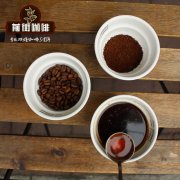Costa Rica Three Rivers Coffee| Coral Mountain Manor Sunlight Kadura SHB Grade Flavor?

Professional coffee knowledge exchange more coffee bean information please follow the coffee workshop (Wechat official account cafe_style)
Costa Rican three Rivers producing area Coffee | Coral Villa Sun Kaddura SHB flavor?
Costa Rican coffee plantations with fertile volcanic ash, mild and suitable temperatures, and stable and abundant rainfall are one of the reasons why coffee has become one of the main agricultural products in Costa Rica. Its coffee beans are all Arabica species. The flavor is pure, the aroma is pleasant, and it has an impeccable balance in acidity and taste. The coffee beans produced at the high latitudes of Costa Rica are famous in the world, full-bodied, mild in taste, but extremely sour. The coffee beans here have been carefully processed, which is why they have high quality coffee. Located in the south of SanJos é, the capital of Tarasu, Costa Rica is one of the most valued coffee growers in the country. Tarasu (Tarrazu) is one of the major coffee producers in the world. Coral Mountain Estate manor is located between the three major production areas of Tarrazu, Cotalillo and Tres Rios. Surrounded by the special triangle, it is affected by the microclimate and achieves the uniqueness and superiority of nutrients. The harvest of each fruit can only be picked under the condition of relative ripening. The mode of manual picking makes the quality of Coral Mountain extremely excellent.
Coffee was introduced into Costa Rica from Cuba in 1729. Today, its coffee industry is one of the well-organized industries in the world, with a yield of 1700 kg per hectare. Costa Rica has only 3.5 million people but 400m coffee trees, and coffee exports account for 25 per cent of the country's total exports. Costa Rica's volcanic soil is very fertile and well drained, especially in the central plateau CentralPlateau, where the soil consists of successive layers of ash and dust. Costa Rican coffee has full particles, ideal acidity and unique strong flavor. In 1948, the Costa Rican government established an exclusive coffee department (ICAFE:Institutodel Caf é de Costa Rica, a Costa Rican coffee industry company). It has been taken over by the official Coffee Committee Oficinadel Caf é), mainly coaching the manor from planting, post-processing to the improvement of the sales system. The place is also very careful in handling coffee for export. Among the exported coffee, coffee beans that are considered to be of substandard quality will be colored by blue plant dyes and then returned to China for sale. Today, about 1/3 of Costa Rica's population is engaged in coffee or coffee-related industries, and per capita coffee consumption is twice that of Italy or the United States. From various policies, we can see that the government's support for the coffee industry has indirectly made Costa Rica's coffee better and more competitive than other countries.
Sanhe Coffee, 1200-1650 meters above sea level, is produced in the vicinity of the Irazu volcano from December to March. This gourmet coffee bred by the volcano is regarded as Costa Rican's "Bordeaux" coffee. This area is located in the watershed of the Pacific Ocean and has obvious dry and wet seasons. Sanhe District is a traditional coffee producing area, and every cup of coffee from Sanhe District is balanced and rich in taste, leaving fragrance in your teeth and cheeks. The sweet taste is a buffer of acidity, with crispy fruit aromas accompanied by aromas of cocoa, plus an elegant hint of magnolia, as the name suggests. The palate is clean, sweet and persistent. After the re-roasted coffee beans, the elegant flavor is filled with honey nuts, plums, spices and other aromas, leaving a soft but unforgettable taste. Sanhe District coffee taste balanced and rich, her refreshing slightly sour feeling is most suitable for the first cup of coffee in the morning to taste. The output of Sanhe coffee is stable, the quality is good, and the hard selection of bean seeds is the proud product of Costa Rica.
Cup test data:
Dry aroma: honey, ripe fruit, cream, almond, caramel sweetness, melon and fruit
Wet aroma: melon and fruit, woody, nutty, white flowers, oolong tea
Sipping: the melon and fruit aroma of the former population rises, with sweet aroma of ripe fruit, white flower aroma, clean and supple acidity, nutty taste and tea flavor in the middle, obvious wheat aroma in the latter, excellent sweetness and persistence, integrated and moderate flavor, and long-lasting long aftertaste finish.
Manor: Coral Mountain Coral Hill Manor
Grade: SHB
Processing: 100% Sun Dried
Altitude: 1500 m
Variety: Caturra
Qianjie recommended cooking: [V60 hand]
Filter cup: Hario V60
Water temperature: 88 degrees
Degree of grinding: small Fuji degree of grinding 4
Cooking methods: the ratio of water to powder is 1:15, 15g powder, the first injection of 25g water, 25 s steaming, the second injection to 120g water cut off, waiting for the powder bed water to half and then water injection, slow water injection until 225g water, extraction time about 2:00
Analysis: using three-stage brewing to clarify the flavor of the front, middle and back of the coffee. Because the V60 has many ribs and the drainage speed is faster, when the water is cut off, it can prolong the extraction time and better extract the nut and chocolate flavor of the tail section.
Important Notice :
前街咖啡 FrontStreet Coffee has moved to new addredd:
FrontStreet Coffee Address: 315,Donghua East Road,GuangZhou
Tel:020 38364473
- Prev

Kopi Luwak | principle of in vivo fermentation of civets? Sidamo candlelight exquisite sun fermentation treatment?
Professional coffee knowledge exchange for more information about coffee beans, please follow the coffee workshop (Wechat official account cafe_style) Kopi Luwak | the principle of civets' fermentation in vivo? Sidamo candlelight exquisite sun fermentation treatment? Sun drying, showing a strong aroma of wine, this is the most primitive, the most simple, the longest treatment of coffee, according to relevant literature records, as early as 1000 years ago in the 11th century.
- Next

Guatemala Koban production area Vista Beauty Manor introduces what is the flavor of coffee in Koban area?
Professional Coffee knowledge Exchange more information about coffee beans Please follow Coffee Workshop (Wechat official account cafe_style) melon is a nickname for Guatemala. The Mayan town sits on top of 37 volcanoes, two of which erupted in 2010. Coupled with frequent tornadoes and natural disasters everywhere, it is truly dangerous.
Related
- Detailed explanation of Jadeite planting Land in Panamanian Jadeite Manor introduction to the grading system of Jadeite competitive bidding, Red bid, Green bid and Rose Summer
- Story of Coffee planting in Brenka region of Costa Rica Stonehenge Manor anaerobic heavy honey treatment of flavor mouth
- What's on the barrel of Blue Mountain Coffee beans?
- Can American coffee also pull flowers? How to use hot American style to pull out a good-looking pattern?
- Can you make a cold extract with coffee beans? What is the right proportion for cold-extracted coffee formula?
- Indonesian PWN Gold Mandrine Coffee Origin Features Flavor How to Chong? Mandolin coffee is American.
- A brief introduction to the flavor characteristics of Brazilian yellow bourbon coffee beans
- What is the effect of different water quality on the flavor of cold-extracted coffee? What kind of water is best for brewing coffee?
- Why do you think of Rose Summer whenever you mention Panamanian coffee?
- Introduction to the characteristics of authentic blue mountain coffee bean producing areas? What is the CIB Coffee Authority in Jamaica?

